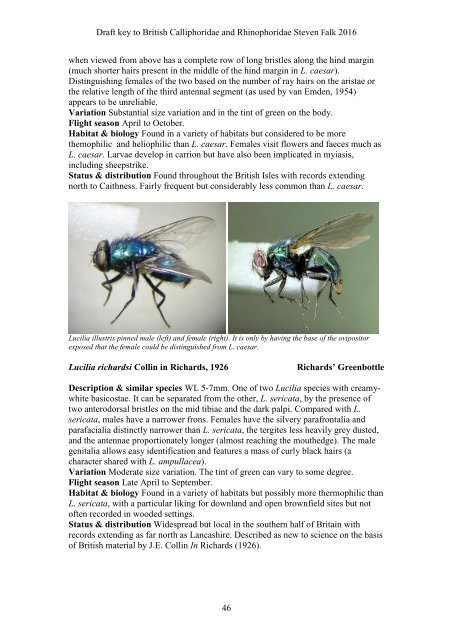BRITISH BLOWFLIES (CALLIPHORIDAE) AND WOODLOUSE FLIES (RHINOPHORIDAE)
4cmTmdCuA
4cmTmdCuA
You also want an ePaper? Increase the reach of your titles
YUMPU automatically turns print PDFs into web optimized ePapers that Google loves.
Draft key to British Calliphoridae and Rhinophoridae Steven Falk 2016<br />
when viewed from above has a complete row of long bristles along the hind margin<br />
(much shorter hairs present in the middle of the hind margin in L. caesar).<br />
Distinguishing females of the two based on the number of ray hairs on the aristae or<br />
the relative length of the third antennal segment (as used by van Emden, 1954)<br />
appears to be unreliable.<br />
Variation Substantial size variation and in the tint of green on the body.<br />
Flight season April to October.<br />
Habitat & biology Found in a variety of habitats but considered to be more<br />
themophilic and heliophilic than L. caesar. Females visit flowers and faeces much as<br />
L. caesar. Larvae develop in carrion but have also been implicated in myiasis,<br />
including sheepstrike.<br />
Status & distribution Found throughout the British Isles with records extending<br />
north to Caithness. Fairly frequent but considerably less common than L. caesar.<br />
Lucilia illustris pinned male (left) and female (right). It is only by having the base of the ovipositor<br />
exposed that the female could be distinguished from L. caesar.<br />
Lucilia richardsi Collin in Richards, 1926<br />
Richards’ Greenbottle<br />
Description & similar species WL 5-7mm. One of two Lucilia species with creamywhite<br />
basicostae. It can be separated from the other, L. sericata, by the presence of<br />
two anterodorsal bristles on the mid tibiae and the dark palpi. Compared with L.<br />
sericata, males have a narrower frons. Females have the silvery parafrontalia and<br />
parafacialia distinctly narrower than L. sericata, the tergites less heavily grey dusted,<br />
and the antennae proportionately longer (almost reaching the mouthedge). The male<br />
genitalia allows easy identification and features a mass of curly black hairs (a<br />
character shared with L. ampullacea).<br />
Variation Moderate size variation. The tint of green can vary to some degree.<br />
Flight season Late April to September.<br />
Habitat & biology Found in a variety of habitats but possibly more thermophilic than<br />
L. sericata, with a particular liking for downland and open brownfield sites but not<br />
often recorded in wooded settings.<br />
Status & distribution Widespread but local in the southern half of Britain with<br />
records extending as far north as Lancashire. Described as new to science on the basis<br />
of British material by J.E. Collin In Richards (1926).<br />
46


